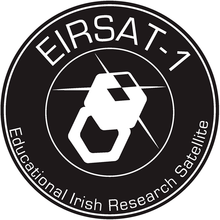EIRSAT-1
 EIRSAT-1 logo | |
| Operator |
ESA Fly Your Satellite! University College Dublin |
|---|---|
| Mission type | 2U CubeSat |
| Homepage | https://www.eirsat1.ie |
| Dimensions | 20cm x 10 cm x 10cm |
The Educational Irish Research Satellite 1 or EIRSAT-1[1] is an Irish space project under development by University College Dublin [2][3][4][5]. The project aims to build, launch and operate the first Irish satellite in space.[1][2][3][4][5]
The satellite project was given approval by the European Space Agency (ESA) in May 2017 as part of the Fly Your Satellite! (FYS) program. Among the Irish-based companies providing help are ENBIO and SensL.[1][2][3][4][5]
Aims
The mission of EIRSAT-1 is to advance education in space science and engineering across the whole island of Ireland through collaboration between student teams, higher education institutions and high-tech companies.
The objectives of EIRSAT-1 are to:
- develop the know-how of the Irish higher education sector in space science and engineering, by supporting student teams to build, test and operate the satellite;
- address skills shortages in the space sector by fostering collaboration between student teams and industry through the launch of three payloads that will demonstrate innovative Irish technology;
- inspire the next generation of students towards the study of STEM subjects by launching the very first Irish satellite.
Payloads
EIRSAT-1 will carry three Irish developed experiments, or payloads.[1][2]
GMOD - The Gamma-ray Module
The first payload element (called the ‘Gamma-ray Module’ or ‘GMOD’) is a miniaturised sensor for use in the detection of gamma-rays from both cosmic and atmospheric phenomena. The sensor is called a silicon photomultiplier (SiPM) and has been developed by SensL Ltd. in Co. Cork (currently part of ON Semiconductor). The SiPM has the potential to revolutionise in-situ and remote sensing of gamma-rays in space by removing the need for conventional photomultiplier tubes that are typically very bulky, fragile and require high voltages to operate.
EMOD - the ENBIO Module
The second payload element (called the ‘ENBIO Module’ or ‘EMOD’) will provide in-orbit demonstration of the novel surface treatments made by ENBIO Ltd. (SolarWhite and SolarBlack). These surface treatments have been developed for use on the ESA Solar Orbiter mission, and EIRSAT-1 will provide the opportunity for these coatings to be thermally tested. The temperature of the coatings will be measured throughout the mission.
WBC - Wave Based Control
The third payload, recently added, is a novel attitude control system developed by the Dynamics and Control Group in the UCD School of Mechanical and Materials Engineering. A spacecraft’s “attitude” is its orientation in space. In this case it will use the Earth’s magnetic field to turn itself in any desired direction. The UCD control technique is called “Wave-Based Control” (WBC). EIRSAT-1 will use a standard control system initially. At some time into the mission, in response to an instruction from Earth, the on-board computer will start using WBC to control the satellite’s attitude, thereby evaluating its performance and, it is hoped, qualifying WBC for space flight.
Launch and operations
Subject to successful reviews, the spacecraft will be delivered to ESA in mid 2020[2]. ESA intend to deploy it from the International Space Station thereafter. It aims to orbit the Earth for one year.
References
- 1 2 3 4 "eirsat1". eirsat1. Retrieved 2018-04-16.
- 1 2 3 4 5 Goodbody, Will (2018-09-24). "Ireland's first satellite moves step closer to launch". RTE.ie. Retrieved 2018-09-24.
- 1 2 3 "Ireland's first ever satellite moves one step closer to launch into space". Engineers Journal. 2018-09-24. Retrieved 2018-09-24.
- 1 2 3 Gorey, Colm (2018-09-24). "Ireland's first satellite one step closer to space after passing major milestone". Silicon Republic. Retrieved 2018-09-24.
- 1 2 3 "Go boldly: Students build prototype for first Irish satellite". The Irish Times. Retrieved 2018-09-24.